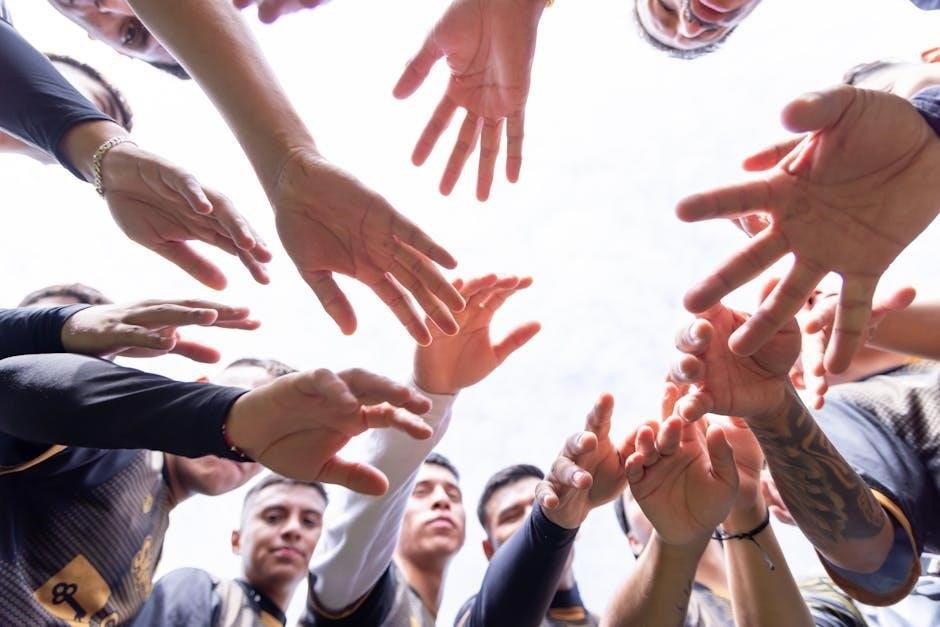Morning meetings are a great way to start the day, fostering community, social-emotional learning, and engagement. They combine greetings, sharing, and activities, with many downloadable resources available for teachers.
What is a Morning Meeting?
A morning meeting is a structured start to the day, fostering connection and engagement. It combines greetings, sharing, and group activities to create a welcoming atmosphere. Designed to set the tone, it helps students feel included and ready to learn. Morning meetings often include discussions, games, or icebreakers, promoting social-emotional learning and teamwork. They are a powerful tool for building classroom community and encouraging active listening. With a variety of activities available, teachers can adapt meetings to suit different grade levels, ensuring meaningful and interactive experiences for all students.
The Importance of Morning Meetings in the Classroom
Morning meetings are essential for fostering a positive classroom environment. They provide a consistent routine, helping students transition smoothly into the school day. These gatherings promote social-emotional learning by encouraging empathy, self-awareness, and communication. Morning meetings also strengthen classroom community by creating opportunities for connection and collaboration. They allow teachers to address individual needs, celebrate achievements, and set daily goals. By fostering engagement and teamwork, morning meetings prepare students mentally and emotionally for learning, ensuring a productive and focused day ahead. Their impact extends beyond academics, shaping students’ social and emotional development.
Benefits of Morning Meetings
Morning meetings foster a sense of community, encourage social-emotional learning, and set a positive tone for the day. They boost engagement and readiness, promoting a productive classroom environment.
Building Classroom Community
Morning meetings are a powerful tool for building a strong, inclusive classroom community. By fostering daily interactions, students develop meaningful connections, reducing social conflicts and encouraging teamwork. Regular sharing and collaborative activities create a sense of belonging, helping students feel valued and supported. Consistent routines and positive interactions establish trust, making the classroom a welcoming space for all. These moments of connection lay the foundation for a cohesive and empathetic group, where diversity is celebrated and everyone feels they belong. A strong community fosters resilience, collaboration, and mutual respect among students.

Encouraging Social-Emotional Learning (SEL)
Morning meetings provide a daily opportunity to encourage social-emotional learning by fostering empathy, self-awareness, and self-management. Activities like sharing feelings, discussing challenges, and practicing active listening help students develop emotional intelligence. Group discussions on topics like kindness, perseverance, and friendship teach valuable life skills. These interactions create a safe space for students to express themselves and learn from one another. By incorporating SEL into morning meetings, educators help students build strong relationships, manage emotions, and develop a growth mindset. These practices lay the foundation for a supportive and inclusive classroom environment.
Setting the Tone for the Day
Morning meetings play a crucial role in setting a positive tone for the day. A well-structured morning routine helps students transition smoothly from home to school, fostering readiness to learn. Consistent greetings, sharing, and group activities create a sense of predictability and comfort. Starting the day with positivity, clarity, and purpose encourages students to approach challenges with confidence. Morning meetings also provide an opportunity to align the class on shared goals, ensuring everyone feels prepared and focused. This intentional start helps cultivate a productive and respectful classroom environment throughout the day.
Improving Student Engagement
Morning meetings are a powerful tool for improving student engagement by creating interactive and meaningful experiences. Activities such as greetings, sharing, and group games encourage participation and connection among students. Interactive discussions and movement-based tasks help students stay focused and motivated. When students feel heard and valued, they are more likely to participate actively in class. Morning meetings also provide opportunities for students to take ownership of their learning, fostering a sense of responsibility and enthusiasm. This engagement often carries over into the rest of the school day, creating a more dynamic and productive classroom environment.

Key Components of a Morning Meeting
Morning meetings consist of structured activities like greetings, sharing, group games, and discussions. These elements foster connection and set a positive tone for the day.
Greetings and Sharing
Morning meetings often begin with greetings and sharing to foster connection. Students and teachers exchange hellos, while sharing allows individuals to discuss thoughts, feelings, or experiences. This creates a welcoming environment, encouraging empathy and inclusivity. Greetings can be verbal, non-verbal, or even song-based, catering to diverse preferences. Sharing may involve reflection prompts or fun questions, helping students articulate their thoughts. This component builds relationships, supports social-emotional growth, and sets a positive tone for the day, ensuring everyone feels valued and heard in the classroom community.
Group Activities and Games
Group activities and games are essential for fostering collaboration and engagement. Games like “The Human Knot” or “Pass the Smile” encourage teamwork and laughter. These activities help students bond, develop problem-solving skills, and build trust. They also provide a dynamic start to the day, boosting energy and focus. Incorporating movement and interaction, these exercises create a sense of unity and prepare students for collaborative learning. By participating in fun, structured games, students develop social skills and a positive classroom culture, making mornings enjoyable and productive.
Discussion Prompts and Icebreakers
Discussion prompts and icebreakers are powerful tools to spark conversation and connection; They help students feel comfortable sharing their thoughts and ideas. Examples include “Would you rather…” scenarios, “Two truths and a lie,” or reflective questions like “What are you grateful for today?” These activities encourage participation, foster empathy, and build relationships. They also provide opportunities for students to practice articulating their thoughts clearly. By incorporating these exercises, teachers create a supportive environment where students feel heard and valued, setting a positive tone for the day. They are simple yet effective ways to deepen classroom connections and promote meaningful dialogue.

Wrap-Up and Transition
The wrap-up and transition phase of a morning meeting ensures a smooth shift to the next part of the day. Teachers can summarize key points discussed, reinforce positive behaviors, and preview upcoming activities. This helps students mentally prepare for what’s next. Simple strategies like a quick reflection, a group cheer, or a countdown timer can signal the end. A well-executed transition maintains momentum and keeps the classroom focused. It’s a crucial step to ensure the meeting’s goals are met and students are ready to engage in their daily tasks with clarity and purpose.
Popular Morning Meeting Activities
Morning meetings often feature greeting games, movement activities, team-building exercises, and icebreakers to foster connection and engagement among students, setting a positive tone for the day.
Greeting Games
Greeting games are a delightful way to kick off morning meetings, fostering connection and camaraderie among students. Classics like “The Name Game” help students learn each other’s names through repetition and rhyme. “The Wave and Hello” is a simple yet effective activity where students wave and say hello to peers around the circle. “High-Five Hello” adds a playful twist, encouraging physical interaction and energy. For younger grades, “The Hello Song” engages students with music, while “Partner Greeting” allows for personalized interactions. These activities not only build community but also set a positive tone for the day ahead.
Movement Activities
Movement activities energize students and prepare their minds for the day ahead. Simple stretches, yoga poses, or a quick dance party can boost energy levels. “Follow the Leader” encourages imitation and laughter, while “Simon Says” promotes listening skills. For younger grades, “Animal Moves” lets students mimic creatures, fostering creativity. Older students might enjoy “Freeze Dance” or “Red Light, Green Light” to practice self-control. These activities not only get hearts racing but also create a lively, engaging atmosphere, making mornings more enjoyable and setting a positive tone for learning.
Team-Building Exercises
Team-building exercises foster collaboration and trust among students. Activities like the “Human Knot” or “Pass the Object” encourage problem-solving and communication. In the “Human Knot,” students stand in a circle, grasp hands, and work together to untangle without letting go. “Pass the Object” involves passing an object using only specific body parts, promoting coordination and teamwork. These exercises strengthen relationships and prepare students for collaborative tasks throughout the day. They also create a sense of unity, making the classroom a supportive and inclusive environment for everyone.

Icebreakers and Sharing Ideas
Icebreakers and sharing ideas are essential for fostering connections and encouraging participation. Activities like “Two Truths and a Lie” or “Would You Rather” spark fun conversations. Students can share thoughts on prompts like “What’s your favorite book?” or “What did you do over the weekend?” These exercises build confidence, promote active listening, and create a supportive environment. Sharing ideas also helps students feel valued and heard, fostering a positive classroom culture. These activities are simple yet effective for breaking down barriers and encouraging meaningful interactions among students of all ages.

Morning Meeting Ideas for Different Grade Levels
Morning meetings can be tailored to suit various age groups. For younger grades, simple games and sharing circles work well. Older students benefit from problem-solving activities and reflective discussions. These age-specific approaches ensure engagement and relevance, fostering a positive start to the day for all learners.
Activities for Kindergarten and First Grade
For younger students, morning meetings focus on fun, interactive activities. Singing songs like The Alphabet Song or If You’re Happy and You Know It engages children. Movement games, such as jumping jacks or clapping rhymes, get bodies moving. Sharing circles allow students to discuss their weekends or favorite colors, fostering connection. Simple group activities, like passing a beanbag while music plays, encourage teamwork. Visual schedules and emotion charts help students transition smoothly. These activities are short, lively, and tailored to young attention spans, setting a positive tone for the day while teaching social and emotional skills. They are easy to adapt and require minimal preparation.
Engaging Ideas for Second and Third Grade
For second and third graders, morning meetings can include more structured yet engaging activities. Team-building games, such as solving simple puzzles or building bridges with popsicle sticks, foster collaboration. Creative writing prompts, like writing about a perfect day, encourage self-expression. Movement breaks, such as jumping jacks or quick dances, keep energy levels balanced. SEL-focused discussions, like sharing ways to show kindness, promote empathy. Quick games like “Would You Rather” or charades add fun and laughter. These activities challenge students while keeping them excited and focused, making morning meetings a highlight of their day.
Challenging Activities for Fourth to Sixth Grade
For fourth to sixth graders, morning meetings can include more complex, thought-provoking activities. Group debates on current events or ethical dilemmas encourage critical thinking and public speaking. Collaborative problem-solving, such as escape room-style challenges, fosters teamwork and creativity. Writing reflections on historical figures or societal issues deepens empathy and understanding. Science-based games, like predicting weather patterns, spark curiosity. These activities are designed to challenge older students academically and socially, preparing them for the day ahead with confidence and engagement.
How to Incorporate SEL into Morning Meetings
Start with emotional check-ins, where students share feelings or concerns. Use group discussions on topics like kindness or respect to foster empathy and teamwork. Incorporate active listening exercises to help students engage deeply with peers’ thoughts and perspectives.
Teaching Empathy Through Sharing
Encourage students to share personal stories or challenges, fostering a safe space for open dialogue. This practice helps students connect emotionally and understand different perspectives. By listening to peers, they develop compassion and learn to support one another. Teachers can guide discussions to highlight empathy, creating a supportive classroom culture; Sharing experiences also builds trust and strengthens relationships, making it easier for students to collaborate and resolve conflicts. Over time, this practice cultivates a community of understanding and kindness, preparing students to navigate social situations with empathy and grace.
Practicing Active Listening
Active listening is a powerful skill cultivated during morning meetings. Teachers can model attentive behavior by maintaining eye contact and nodding. Students can practice by listening to a classmate’s story without interrupting, then summarizing what they heard. Activities like “Listen and Repeat” or “Silent Sharing” reinforce focus and comprehension. This fosters a respectful environment where voices are valued. Over time, students develop the ability to truly hear and understand others, improving communication and empathy. Such practices not only enhance learning but also prepare students to navigate real-world interactions with greater sensitivity and effectiveness.
Building Self-Awareness
Morning meetings are an ideal space for students to develop self-awareness. Activities like daily reflections or sharing feelings encourage students to identify and express their emotions. Teachers can incorporate prompts like “What am I grateful for today?” or “What’s one goal I have?” to help students connect with their thoughts and feelings. This practice fosters self-reflection and helps students recognize their strengths and areas for growth. By regularly engaging in these exercises, students build a stronger understanding of themselves, which can lead to improved self-confidence and decision-making skills throughout the day.

Creative Ways to Energize Morning Meetings
Energize morning meetings with dynamic activities like music-based warm-ups, quick games, or brainstorming sessions. Incorporate movement and interaction to boost engagement and set a lively tone.
- Use upbeat music to encourage movement.
- Include quick team-building challenges.
- Rotate roles to involve all students.
Using Music and Movement
Music and movement are powerful tools to energize morning meetings. Start with upbeat songs to set a positive tone, then incorporate simple stretches or dance breaks. Movement activities like yoga poses or action songs engage students physically and mentally. This approach fosters creativity, collaboration, and enthusiasm. Use rhythmic exercises to transition smoothly into discussions or games. Rotate song choices to reflect diverse preferences and cultures, ensuring inclusivity. Movement breaks also help students refocus, promoting readiness for the day ahead. Make it interactive by letting students suggest songs or lead movements, creating a sense of ownership and shared joy in the process.
Adding Arts and Crafts
Arts and crafts enrich morning meetings by fostering creativity and teamwork. Simple activities like drawing, coloring, or creating group murals encourage collaboration. Students can craft shared journals or decorate classroom spaces, building a sense of community. Quick DIY projects, such as paper flowers or collaborative collages, inspire creativity while keeping the session engaging. These activities also allow students to express emotions and ideas visually, promoting self-expression. Arts and crafts make morning meetings more dynamic and meaningful, leaving students with a sense of accomplishment and shared joy in their creations.
Incorporating Storytelling
Storytelling is a powerful way to captivate students during morning meetings. Teachers can share personal anecdotes, read aloud from books, or use narratives to discuss social-emotional topics. Students can also take turns sharing their own stories, fostering connection and empathy. Interactive storytelling, such as group storytelling or “what if” scenarios, encourages creativity and collaboration. This activity helps set a positive tone for the day, reinforces SEL skills, and builds a sense of community. Storytelling also engages students’ imaginations, making morning meetings both educational and enjoyable. It’s a simple yet impactful way to start the day on a meaningful note.
Downloadable Resources for Morning Meetings
Access a variety of free morning meeting PDFs, including activity cards, lesson plans, and icebreakers. These resources are designed to be engaging, customizable, and easy to print, saving teachers time while fostering meaningful interactions and a positive classroom environment.
Free PDF Downloads for Teachers
Discover a wide range of free PDF downloads designed to support morning meetings. These resources include pre-designed activity cards, lesson plans, and printable templates to streamline preparation. Teachers can access icebreakers, discussion prompts, and team-building exercises tailored for various grade levels. Many PDFs are customizable, allowing educators to adapt activities to their classroom needs. Websites like Teachers Pay Teachers and education blogs offer these materials, providing convenient tools to enhance engagement and foster a positive classroom atmosphere. These downloads save time and inspire creativity, ensuring morning meetings are both productive and enjoyable for students and educators alike. Easy to print and share.
Printable Activity Cards
Printable activity cards are versatile resources for morning meetings, offering a variety of engaging tasks. They often include discussion prompts, icebreakers, and team-building exercises tailored for different grade levels. These cards are easy to print and distribute, saving teachers valuable time. Many sets are customizable, allowing educators to adapt activities to their students’ needs. They can be used daily to encourage participation, foster creativity, and promote social-emotional learning. Popular activities include “Would You Rather” questions, feeling check-ins, and collaborative puzzles. These cards provide structure and flexibility, ensuring morning meetings are both meaningful and enjoyable for all students.
Sample Morning Meeting Plans
Sample morning meeting plans provide structured templates for educators to organize daily sessions effectively. These plans typically include timed segments for greetings, sharing, activities, and wrap-ups. They often feature themed days, discussion prompts, and engaging games. Teachers can customize these plans to suit their classroom needs and student demographics. Many samples cater to different grade levels, ensuring age-appropriate activities. These plans help maintain consistency and save preparation time, allowing teachers to focus on fostering a positive classroom environment. They also include tips for adapting activities based on class size and student preferences, ensuring flexibility and inclusivity.

Best Practices for Leading Morning Meetings
Effective morning meetings start on time and follow a consistent routine, ensuring student engagement and active participation. Keep discussions focused and time-efficient.
Keeping Meetings Engaging and Focused
To maintain engagement, incorporate variety and interactivity into morning meetings. Use discussion prompts, group games, and movement activities to keep students attentive. Ensure clear expectations and timely transitions to avoid distractions. Encourage active participation by rotating roles and providing opportunities for all voices to be heard. Use positive reinforcement to celebrate contributions and foster a supportive environment. Finally, keep activities age-appropriate and aligned with daily goals to ensure meetings remain purposeful and productive for all students.

Encouraging Student Participation
Foster a welcoming atmosphere where every student feels valued. Use icebreakers and open-ended questions to encourage sharing. Rotate roles like leader or discussion starter to empower students. Incorporate brainstorming or group activities that require collaboration. Celebrate diverse perspectives and ensure all voices are heard. Offer choices in activities to cater to different interests. Consistently encourage participation by praising effort and creativity, helping even shy students feel confident to contribute. This inclusive approach builds confidence and strengthens the classroom community.
Timing and Pacing
Consistency is key to effective morning meetings. Start and end on time to establish a routine. Allocate specific time for each component, such as 10 minutes for greetings and 5 minutes for wrap-up. Use a timer to keep the meeting focused and avoid prolonging discussions. Allow flexibility for meaningful conversations but maintain a structured flow. Incorporate a transition activity to signal the end of the meeting. Keeping the duration between 15-20 minutes ensures engagement without overwhelming students. Proper timing fosters productivity and sets a positive tone for the day.

Real-World Examples of Successful Morning Meetings
Schools worldwide use morning meetings to foster connection. A 4th-grade class in Texas saw improved behavior after implementing daily sharing circles. In Oregon, a 2nd-grade teacher reported increased student participation.
Case Studies from Teachers
Teachers worldwide share inspiring stories of morning meeting success. In one case, a 3rd-grade teacher in California used daily sharing circles to improve student empathy, resulting in fewer conflicts. A kindergarten teacher in New York incorporated movement activities, boosting students’ focus and energy levels. A 5th-grade teacher in Florida reported increased class cohesion after introducing team-building games. These real-world examples highlight how tailored morning meeting activities can transform classroom dynamics, fostering connection and readiness for learning. By adapting activities to their students’ needs, teachers create meaningful experiences that last beyond the meeting itself.
Student Feedback and Testimonials
Students consistently highlight the positive impact of morning meetings on their daily experience. One 4th-grader shared, “Morning meetings make me feel connected to my classmates.” A 2nd-grader expressed, “I love sharing my thoughts and hearing others.” High school students also appreciate the structure, with one noting, “It helps me start the day organized and focused.” These testimonials emphasize how morning meetings foster a sense of belonging, improve communication, and prepare students mentally for the day ahead. Such feedback underscores the lasting benefits of these activities on students’ social and emotional well-being.
